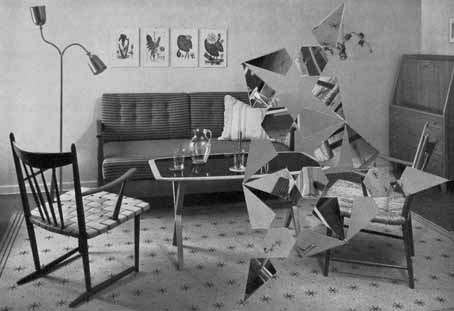Artist:
Bojan Šarčević (born 1974 in Belgrade, Serbia; lives and works in Paris, France and Berlin, Germany).
Materials:
Offset prints and collage; variable dimensions.
Description:
“The collages’ vague sense of time and place is located somewhat more precisely by their title, 1954… which refers to the 1954 edition of the German architectural journal Baumeister, from which the pictures are taken. Germany in 1954, after two lost decades and the horrors of war, was tentatively starting to rebuild its traumatized national morale (helped in no small measure by the country’s unexpected World Cup victory that same year). And, despite the absence of the country’s greatest modern architects, Walter Gropius and Ludwig Mies van der Rohe, architecture flourished in the steady rebuilding of cities reduced to rubble by Allied bombing, and was characterized by a cautiously optimistic Modernism. This was the year that Mies began his monumental Seagram building in New York, but the pictures Šarčević collects here are more modest examples of a socially oriented Modernism, felt at the time to be not only an expression of, but also a form of active participation in, the creation of Germany’s new democracy.”
—”1954 (2004) – Bojan Šarčević,” Rhizome, May 31, 2011.
“Issues of the 100-year old architecture magazine baumeister dating from 1954 provided the basis for Bojan Šarčević’s black-and-white offset prints, to which he has added abstractly picturesque ornaments. The crystalline structures or meandering bands add an attractive, second visual layer to the austerity of various entrance halls, living rooms, staircases, and classrooms, starting to break the images up into fractal details, like a jigsaw puzzle that has been put together wrongly. These living rooms and homes, furnished and decorated in what was then the advanced spirit of the day, must have been photographed in impeccable condition immediately after they were completed, and they appear in a state of artistic destruction in Šarčević’s series of a total of 76 collages called 1954, 2004. This clear look at history gives way to the view through a kaleidoscope. Šarčević’s ornamental insertions create historical empty spaces, the documentary significance of the photos is diminished.”
—”Bojan Šarčević,” Daimler Art Collection website.


